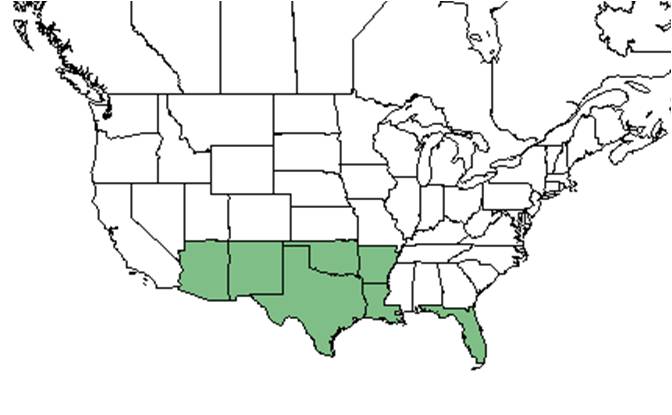Difference between revisions of "Rivina humilis"
Krobertson (talk | contribs) (→Cultivation and restoration) |
|||
| Line 18: | Line 18: | ||
}} | }} | ||
| − | Common names: | + | Common names: Bloodberry rougeplant, Rougeplant, Pigeonberry, Baby-pepper |
==Taxonomic notes== | ==Taxonomic notes== | ||
| − | |||
==Description== | ==Description== | ||
<!-- Basic life history facts such as annual/perrenial, monoecious/dioecious, root morphology, seed type, etc. --> | <!-- Basic life history facts such as annual/perrenial, monoecious/dioecious, root morphology, seed type, etc. --> | ||
| Line 31: | Line 30: | ||
===Habitat=== <!--Natural communities, human disturbed habitats, topography, hydrology, soils, light, fire regime requirements for removal of competition, etc.--> | ===Habitat=== <!--Natural communities, human disturbed habitats, topography, hydrology, soils, light, fire regime requirements for removal of competition, etc.--> | ||
Habitats of ''R. humilis'' include damp shady sites, riparian vegetation, disturbed sites, and waste areas.<ref name="key">[[http://keyserver.lucidcentral.org/weeds/data/080c0106-040c-4508-8300-0b0a06060e01/media/html/Rivina_humilis.htm]]Accessed: March 10, 2016</ref> It is usually found on moist to well drained soils in both light shade and partial sun.<ref name="plantdelight">[[http://www.plantdelights.com/Rivina-humilis-for-sale/Buy-Pigeonberry/]]Accessed: March 10, 2016</ref> | Habitats of ''R. humilis'' include damp shady sites, riparian vegetation, disturbed sites, and waste areas.<ref name="key">[[http://keyserver.lucidcentral.org/weeds/data/080c0106-040c-4508-8300-0b0a06060e01/media/html/Rivina_humilis.htm]]Accessed: March 10, 2016</ref> It is usually found on moist to well drained soils in both light shade and partial sun.<ref name="plantdelight">[[http://www.plantdelights.com/Rivina-humilis-for-sale/Buy-Pigeonberry/]]Accessed: March 10, 2016</ref> | ||
| − | |||
===Phenology=== <!--Timing off flowering, fruiting, seed dispersal, and environmental triggers. Cite PanFlora website if appropriate: http://www.gilnelson.com/PanFlora/ --> | ===Phenology=== <!--Timing off flowering, fruiting, seed dispersal, and environmental triggers. Cite PanFlora website if appropriate: http://www.gilnelson.com/PanFlora/ --> | ||
Blooms March through October.<ref name="wildflower"/> | Blooms March through October.<ref name="wildflower"/> | ||
| Line 37: | Line 35: | ||
<!--===Seed bank and germination===--> | <!--===Seed bank and germination===--> | ||
<!--===Fire ecology===--> <!--Fire tolerance, fire dependence, adaptive fire responses--> | <!--===Fire ecology===--> <!--Fire tolerance, fire dependence, adaptive fire responses--> | ||
| − | |||
===Pollination=== | ===Pollination=== | ||
The following Hymenoptera families and species were observed visiting flowers of ''Rivina humilis'' at Archbold Biological Station: <ref name="Deyrup 2015">Deyrup, M.A. and N.D. 2015. Database of observations of Hymenoptera visitations to flowers of plants on Archbold Biological Station, Florida, USA.</ref> | The following Hymenoptera families and species were observed visiting flowers of ''Rivina humilis'' at Archbold Biological Station: <ref name="Deyrup 2015">Deyrup, M.A. and N.D. 2015. Database of observations of Hymenoptera visitations to flowers of plants on Archbold Biological Station, Florida, USA.</ref> | ||
Halictidae: ''Lasioglossum pectoralis'' | Halictidae: ''Lasioglossum pectoralis'' | ||
| + | |||
<!--===Use by animals===--> <!--Herbivory, granivory, insect hosting, etc.--> | <!--===Use by animals===--> <!--Herbivory, granivory, insect hosting, etc.--> | ||
<!--===Diseases and parasites===--> | <!--===Diseases and parasites===--> | ||
Revision as of 15:22, 15 September 2016
| Rivina humilis | |
|---|---|

| |
| Photo by Shirley Denton (Copyrighted, use by photographer’s permission only), Nature Photography by Shirley Denton | |
| Scientific classification | |
| Kingdom: | Plantae |
| Division: | Magnoliophyta - Flowering plants |
| Class: | Magnoliopsida – Dicotyledons |
| Order: | Caryophyllales |
| Family: | Phytolaccaceae |
| Genus: | Rivina |
| Species: | R. humilis |
| Binomial name | |
| Rivina humilis L. | |

| |
| Natural range of Rivina humilis from USDA NRCS Plants Database. | |
Common names: Bloodberry rougeplant, Rougeplant, Pigeonberry, Baby-pepper
Contents
Taxonomic notes
Description
A description of Rivina humilis is provided in The Flora of North America.
Distribution
It is found in southern North America from Florida to Arizona, north to Oklahoma and Arkansas, south through central America and the Caribbean to tropical South America.[1]
Ecology
Habitat
Habitats of R. humilis include damp shady sites, riparian vegetation, disturbed sites, and waste areas.[2] It is usually found on moist to well drained soils in both light shade and partial sun.[3]
Phenology
Blooms March through October.[1]
Pollination
The following Hymenoptera families and species were observed visiting flowers of Rivina humilis at Archbold Biological Station: [4]
Halictidae: Lasioglossum pectoralis
Conservation and management
Cultivation and restoration
Used in the southwest as red dye.[3] This species is poisonous.[5]
Photo Gallery
References and notes
- ↑ 1.0 1.1 [[1]]Lady Bird Johnson Wildflower Center. Accessed: March 10, 2016
- ↑ [[2]]Accessed: March 10, 2016
- ↑ 3.0 3.1 [[3]]Accessed: March 10, 2016
- ↑ Deyrup, M.A. and N.D. 2015. Database of observations of Hymenoptera visitations to flowers of plants on Archbold Biological Station, Florida, USA.
- ↑ [[4]] Accessed: March 10, 2016